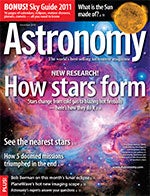
Waukesha, Wis. — Astronomers have a pretty good idea of how stars form. These objects start out as vast clouds of gas until a nearby supernova or some other object triggers overdense regions. Those small areas become denser clumps, and over time, the clump becomes a full-fledged hydrogen-fusing star.Well, it’s not that simple, as I explain in “How stars form.” Nearby massive stars, other sun-forming clouds, and even the Milky Way’s spiral structure affect how stars form. And how do stellar groups form? How do the individual suns divvy out the available material? Astronomers must answer these questions and others to fully understand star formation. Some groups are incorporating advanced computer simulations, while others use deep observations to find stars in their early stages.For an overview about how stars form and the tripping points astronomers must overcome to fully understand the process, pick up the December issue of Astronomy, on newsstands November 2.
“How five doomed missions triumphed in the end”
Not all missions have been successes. Many spacecraft have failed early in their journeys, and some later (think the Mars Polar Lander and the Comet Nucleus Tour). However, a few missions suffered initial setbacks but went on to expand our knowledge of the universe. Senior Editor Richard Talcott overviews five such missions, including the Hubble Space Telescope and Voyager 2, in “How five doomed mission triumphed in the end.”
“Astronomy magazine’s Sky Guide 2011”
Martin Ratcliffe and Richard Talcott preview 2011’s most noteworthy sky events in this 16-page pullout guide. Sky highlights for next year include:
- Watch Epsilon Aurigae return to view — Every 27, years this mysterious star dims by more than half, from magnitude 3.0 to 3.8. After 18 months of faintness, it returns to full brightness in the first half of 2011.
- Saturn’s rings open wide — The ringed planet reaches opposition and peak visibility April 3. The tilt of its rings opens to 9° and by year’s end it will be 15°.
- The Moon takes a bite from the Sun — 2011 hosts six eclipses: four partial of the Sun and two total of the Moon. The best solar eclipse for North American observers comes June 1; the best lunar eclipse is December 10.
December night-sky events visible without optical aid
December 4: Venus is at greatest brilliancy (magnitude –4.9).
December 14: Geminid meteor shower peaks.
December 21: The first total lunar eclipse visible across North America since February 2008 occurs.
Also in the December 2010 Astronomy
- “What’s the Sun made of?” — By analyzing the Sun’s light, astronomers are learning about not only our star’s makeup, but also the early solar system.
- “See the nearest stars” — The stars next door are fun to hunt, easy to spot, and can teach you about astrophysics.
- “PlaneWave’s hot new astroimaging scope” — The new CDK17 telescope offers thermal stability, ease of use, and killer images.
- “The Sky this Month” — Exclusive pullout star charts will guide you through the night sky.
- The December issue of Astronomy also includes Astro News, Bob Berman’s Strange Universe, Glenn Chaple’s Observing Basics, Stephen James O’Meara’s Secret Sky, David Levy’s Evening Stars, Tony Hallas’ Imaging the Cosmos, Ask Astro, Astro Confidential, Deep-sky Showcase, The Cosmic Grid, New Products, and Reader Gallery









